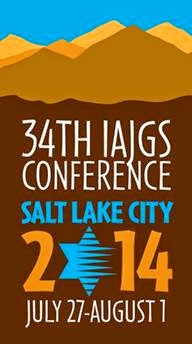It took a while to locate this record. When at first I couldn't find it in either Ancestry's or FamilySearch's indices, I considered that, perhaps, my great grandfather, Isidore Morris, had been too old for World War I draft registration. My estimate of his birth year (1874) was just on the cusp of ineligibility. Isidore registered in the third registration of men eligible for the selective service during World War I.
The Selective Service Act of 18 May 1917 (P.L.65-12, 40 Stat. 76) authorized raising an army. Three draft registrations (and a supplemental one) ensued:
- 5 June 1917: all men between ages of 21-31 (born in years 1885 - 1896).
- 5 June 1918: all men who had turned 21 after 5 June 1917 (1885 - 1897)
- 24 August 1918: supplemental registration for all men be became 21 after 5 June 1918 (1885 - 1897)
- 12 September 1918: all men ages 18-45 (1873 - 1900)
It turns out Isidore's first name was just written incorrectly on the card as Ididore (and I do not know why, but when I query on surname Morris, born in Russia in 1874, his record does not come up among the results in FamilySearch).
 |
| "World War I Draft Registration Cards, 1917-1918," digital images, Ancestry.com (http://www.ancestry.com : accessed 14 August 2010), card for Ididore [Isidore] Morris , no. 3138, New York County Draft Board 160, citing World War I Selective Service System Draft Registration Cards, 1917 - 1918, National Archives microfilm publication M1509; imaged from Family History Library microfilm roll 1,786,852. |
Items in red text will be discussed further.
REGISTRATION CARD
SERIAL ORDER
NUMBER 3138 NUMBER A2381
1. Name: Ididore Morris
2. Permanent Home Address: 243 E. 105 New York, City
3. Age by Years: 44
4. Date of Birth: May 18, 1874
5. Race: White
14. Alien - Non-declarant
15. If not a citizen of the U.S., of what nation are you a citizen or subject? Russia
16. Present Occupation: glacier
17. Employer's Name: self
18. Place of employment of business: 239 E. 105 New York, N.Y.
19. Nearest Relative Name: Sarah Morris
20. Nearest Relative Address: 243 E. 105 N.Y. City
I affirm that I have verified above answers and that they are true.
Registrant's signature or mark: /s/ I. Morris
Description of registrant
Height: tall
Build: medium
Color of eyes: black
Color of hair: black
Date of registration: 9 12 18
--------------------
Isidore's first name is variably spelled on records as either Isidore and Isador (with or without the letter e at the end). So, I had not anticipated "Ididore." Of course, his name is the old country had been Yitzchak, so any spelling of the new name would do in the new country.
I have thus far been unsuccessful in determining whether Isidore ever became a citizen. If he did, he did so after his eldest daughter married on 12 August 1916. [1] She naturalized in August 1943.[2] At some point I may have to contact USCIS and have them search for me.
We genealogists always say that spelling does not count. In this case, I think it does. Since I do not think my great grandfather worked as a slow moving mass of ice, I believe that his occupation should have been written as "glazier."
Notes:
1. New York County, New York, Certificate and Record of Marriage no. 19923 (12 August 1916), Jacob Garber and Dora Morris, New York City Municipal Archives, New York.
2. Dora Garber Petition for Naturalization (1943), Volume 1354,
petition number 378602, U.S. District Court, Eastern District, Brooklyn, New York.

.jpg)












